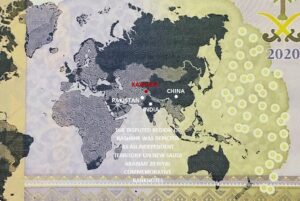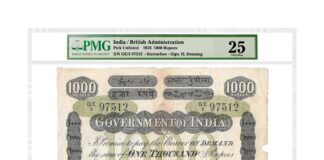
It isn’t very often that an item of currency can be seen the cause of a serious diplomatic dispute between countries, but this is exactly what recently occurred over the release of a commemorative banknote. On the 25th October 2020, The Saudi Arabian Monetary Agency – SAMA announced the issue of new 20 Riyal banknotes (US$ 5.35) in honour of the Kingdom’s presidency and hosting of the G20 Summit. This in itself is an unusual move as Saudi Arabia has only once before issued a 20 Riyal commemorative banknote. The occasion was the Gulf Arab country’s hosting a summit of the G20, an off-shoot of the G7 summit and the first-ever occasion for an Arab country to host such an international event. Founded in 1999, members of the G20 comprise nineteen countries and the European Union with their own representative to discuss developing economies in terms of trade and finance.
Currently, those members include Argentina, Australia, Brazil, Canada, China, Germany, France, India, Indonesia, Italy, Japan, Mexico, Russia, Saudi Arabia, South Africa, South Korea, Turkey, the United Kingdom and the United States. Since 2011, the Summit has met annually and is usually attended by heads of state or government as well as finance ministers, foreign ministers and think-tanks who periodically confer at these summits. It seeks to address issues that go beyond the responsibilities of any one organisation and the presidency is a rotational system which member states are given the opportunity to host, 2020 being Riyadh’s turn. Owing to the lingering Wuhan flu or COVID-19 pandemic plaguing the planet, the summit was moved to a virtual venue but still chaired by the Kingdom’s ruler, HM King Salman, in power since January 2015. The two-day summit was launched on the 21st November and began with a list of declarations and strategies proposed to combat the economic impact the pandemic has had on just about every economy. HM King Salman, from the comfort of his office in Riyadh and entirely online officially launched the conference and directly addressed the pandemic with his opening comments: “It is unfortunate that we are unable to host you in person in Riyadh, due to the exceptional circumstances that we are all facing this year, our peoples and economies are still suffering from this shock. However, we will do our best to overcome this crisis through international cooperation.”

A Banknote Caused Diplomatic Tension
However, the fall-out from the summit wasn’t due to any controversial comments made by world leaders in attendance but ostensibly by the banknote issued on the 25th October. Intended to circulate alongside the other banknotes of 5 to 500 riyals, the eye-catching banknote printed on paper which includes on the reverse side, features a map of the world, centred and depicting the G20 member countries highlighted. The map depicts a point of light symbolising the locale or meeting point of these countries on its land, and the Kingdom’s importance as a source of civilization and economic prominence. Of contentious concern is the fact the map depicts the region of Kashmir – a long-disputed part of the world where all or part of this territory are intensely claimed by India, Pakistan and China.
Shortly after the note’s official release, Indian authorities reacted with increased concern since the map on the reverse side of the banknotes depict the entire disputed territory of Kashmir as separate from India, Pakistan or China, who all administer parts of the erstwhile region. India and its decades-old rival Pakistan, a predominantly Moslem nation have been involved in an ongoing dispute over the territory which both countries claim sovereignty over and predominantly administer. However, in June of this year the dispute became deadly when twenty Indian border guards were shot and killed by Chinese army soldiers as they push for increasing territory and authority in Kashmir. The border clash occurred in the Galwan Valley, adjacent to the Kashmiri border and caused a major international incident.
The Indian and Saudi governments enjoy friendly relations with Riyadh financing a number of projects in India as well as utilising a significant number of Indian migrant workers throughout the Kingdom. In a move of protest against the issue of the banknote, New Delhi’s Ministry of External Affairs spokesperson Anurag Srivastava described the map on the back of the note as a “gross misrepresentation” of sovereign territory. Through diplomatic channels, the Indian Ministry has formally asked the Saudi government to “take urgent corrective steps in this regard” asserting that “the entire Union Territories of Jammu and Kashmir and Ladakh are integral parts of India”.

In the case of Pakistan who are not a member of the G20, and have not publicly commented on the note’s issuance as the map omits Pakistani-occupied-Kashmir including Gilgit-Baltistan as being part of Pakistani territory. Though Pakistan considers Saudi Arabia as a key ally, the exclusion of Kashmir as separate from Pakistan is seen by many in Islamabad as a major rebuke to the country. China, who also claim territory in Kashmir and whose soldiers fatally shot twenty Indian border guards in June, have so far not publicly commented on the map or the banknote itself. As Beijing imports nearly sixteen percent of all their energy needs from the Gulf kingdom, it is perhaps unlikely they will upset their trade deal with Riyadh by doing so.
In response, the SAMA have not publicly admitted to this error as accidental or offered an explanation as to how the depiction was included on the commemorative banknotes but it is understood by Indian media they have agreed to initiate corrective steps. As a result of India’s official protest, it has been suggested these corrective steps may include no longer issuing the commemorative banknotes and withdrawing them from general use as well, although no formal notice has yet been published by the Saudi Arabian Monetary Authority.
The Banknote’s Specifications
The 20 riyal commemorative banknotes are printed on cotton-based paper and predominantly blue-purple with corresponding olive-gold and a coordinating underprint. Measuring 152 / 69 millimetres, the obverse side includes a depiction of HM King Salman Bin Abdul Aziz Al Saud which is positioned towards the right half. In the centre is an illustration of the specially commissioned G20 Logo. Unveiled in December 2019 when the Saudi Arabian Government assumed the presidency of the G20, the logo’s design is the work of Saudi Arabian graphic artist Mohammed Al-Hawas. The logo is inspired by Sadu, traditional coloured filaments from Bedouin fabrics and which features the national colours of participating countries. The Sadu design over time spread to the Arabian Peninsula and has been inscribed by UNESCO on the List of Intangible Heritage of Humanity. The reverse side includes the western numerals denoting the year of issue “2020” and features a map of the world, centred and denoting the G20 countries in contrasting colour. The map depicts a point of light symbolising the locale or meeting point of these countries on its land, and the Kingdom’s importance as a source of civilization and economic prominence.
For additional information on this and the currently circulating coins and banknotes issued by the Saudi Arabian Monetary Authority, please visit their website.
Here you can find a pdf document describing the note’s design.
The author, Michael Alexander, is president of the London Banknote and Monetary Research Centre.




